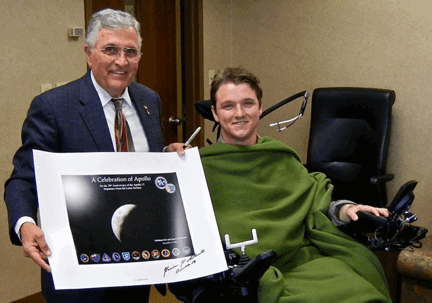NEEP602 Course Notes (Fall 1996)
Resources from Space
Lecture #12: Legacy of the Baby Boomers!
-
o Artist's conception of a Lunar Base (What's wrong with this picture?)
- o Artist's conception of a Moon Base (better).
- o Where have we been on the surface (ground truth) (in addition to extensive photographic and spectral imaging from lunar orbit and some direct as well as indirect geochemical sensing from the Earth and lunar orbit.)
- o Artist's conception of a Moon Base (better).
Notes:
- Non-metallic materials required for lunar construction
- o Regolith cover for insulation and radiation protection
- o Road aggregate (as a by-product from mining and processing of regolith)
- o Dry compacted regolith fines (Desai, 1993)
- o Sintered or cast regolith-based structural materials
- o Regolith/metal fiber composites through thermal liquefaction (Desai, 1993)
 Relatively undisturbed regolith surface.
Relatively undisturbed regolith surface.
 Moderately disturbed regolith surface.
Moderately disturbed regolith surface.
- o Road aggregate (as a by-product from mining and processing of regolith)
- Metallic materials required for lunar operations and manufacturing.
 Lunar Soil Composition
Lunar Soil Composition
 Comparison of compositions of lunar soil and the Earth's crust
Comparison of compositions of lunar soil and the Earth's crust
Note: The overall availability of potential resources on a planet represents a critical baseline - if its not there, forget about it. Locating economically extractable concentrations of such resources, however, constitutes the difference between a potential resource and a commodity. In the following outline, the indicated concentration (grade) of a particular resource is in relation to the concentration in its best known host.
Factors affecting the accessibility of minerals on the Moon-
- o Absence of water!!!!
- o Original rock composition
- o Igneous differentiation (less extreme than on Earth due to absence of water)
- o Regolith formation
- o Fluidized sorting
- o Other ?
- o Igneous differentiation (less extreme than on Earth due to absence of water)
o Native Iron-1 vol% in some mature regolith (also from meteorite debris, about 0.1% of regolith)-
- o Nickel and Cobalt
- o Platinum Group, Ge, Re, and other siderophile elements, e.g. Au
- o Nickel and Cobalt
o TiO2-13 wt% from ilmenite (some in basaltic regolith- o Oxygen and iron (FeO-22 wt% in ilmenite-rich Basalts) can be by-products
o Al2O3-35 wt% (SiO2-45 wt%) from CaAl2Si2O8 (anorthite, the dominant mineral in lunar anorthosite)- o Silicon (Aluminum)
- o Oxygen
- o Sodium
o Cr2O3-0.5-1 wt% from (Fe,Mg)(Cr,Al,Ti)2O4 (spinel in regolith)- o MgO-wt% from (Mg,Fe)2SiO4 (olivine)
- o Note: Significant concentrations of olivine near the base of near surface basalt flows were noted and sampled at the Apollo 12 exploration site in Mare Cognitum.
Other useful elements- o P2O5-0.5 wt% in phosphate minerals in KREEP
- o Na2O-1.2 wt% and K2O-3.6 wt% in KREEP
- o Rare Earth Elements, Hf, and Zr concentrated in KREEP related materials
- o Na2O-1.2 wt% and K2O-3.6 wt% in KREEP
Indigenous volatiles- o Chlorine and fluorine from pyroclastics (orange and green soils)
-
- o Zn, Mn, Cu, Pb, and other chalcophile elements if processed in large volumes.
 In situ orange soil at Shorty Crater
In situ orange soil at Shorty Crater
 Orange soil beads in transmitted light
Orange soil beads in transmitted light
 Large deposits of orange soil along southwestern rim of Serenitatis
Large deposits of orange soil along southwestern rim of Serenitatis
o Sulfur from FeS (troilite) in basaltic regolith
Mineral concentrations possible in differentiated cooling units in the maria- o Titanium (ilmenite), chromium (chromite), iron and sulfur (native iron
and troilite)
Text:
Sullivan, et al., 1991, Using Space Resources, NASA Johnson Space Center, 27p.
Questions:
1. Taking the composition of any Apollo 11 or 17 Ti-rich basalt flow, describe possible mineral enrichments and their layered sequence due to slow cooling and gravitational differentiation in an appropriately thick flow.
2. Do modern applications of rare earth elements suggest that it might be worth while to seek concentrations of such elements for use on the Moon or in Space rather than continue to depend on terrestrial sources? Explain in some detail.
3. List and provide summary descriptions of potential additives necessary to sustain lunar regolith and/or hydroponic based agriculture.
References:
Desai, C.S., et al, 1993, Development and Mechanical Properties of Structural Materials from Lunar Simulants, in Lewis, J., Matthews, M.S., and Guerrieri, M.L., 1993, Editors, Resources of Near-Earth Space, University of Arizona Press.
Haskin, L.A., et al, 1993, A Geochemical Assessment of Possible Lunar Ore Formation, in Lewis, J., Matthews, M.S., and Guerrieri, M.L., 1993, Editors, Resources of Near-Earth Space, University of Arizona Press.
Heiken, G., et al, 1991, Lunar Source Book, Cambridge University Press, Cambridge, 736p.
Lewis, J., Matthews, M.S., and Guerrieri, M.L., 1993, Editors, Resources of Near-Earth Space, University of Arizona Press.
Sullivan, et al., 1991, Using Space Resources, NASA Johnson Space Center, 27p.
Haskin
Criswell
Back to Syllabus
 |
|
University of Wisconsin Fusion Technology Institute · 439 Engineering Research Building · 1500 Engineering Drive · Madison WI 53706-1609 · Telephone: (608) 263-2352 · Fax: (608) 263-4499 · Email: fti@engr.wisc.edu |
Copyright © 2003 The Board of
Regents of the University of Wisconsin System.
For feedback or accessibility issues, contact
web@fti.neep.wisc.edu.
|
